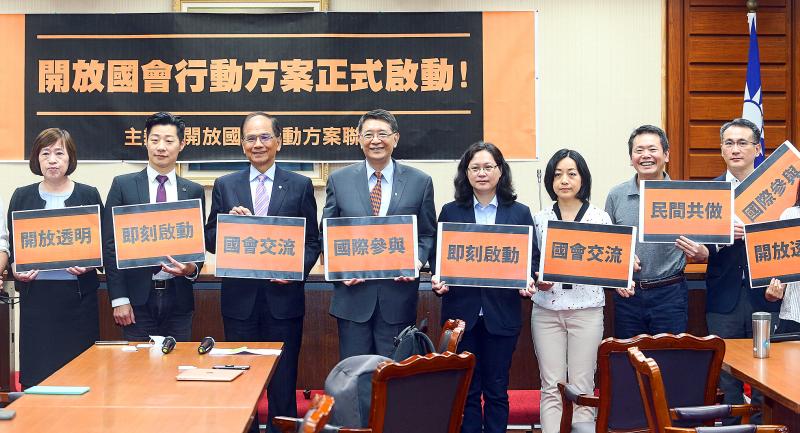Independent Legislator Freddy Lim (林昶佐) yesterday in Taipei launched the Open Parliament Partnership Action Plan in a bid to promote transparency in the Legislative Yuan, increase exchanges with Open Government Partnership (OGP) member states and raise the nation’s international profile.
Citing as examples a “mask map” jointly designed by Minister Without Portfolio Audrey Tang (唐鳳) and members of the public, and Citizen’s Congress Watch’s routine perusal of recordings of legislative question-and-answer sessions on Parliamentary TV to rate lawmakers’ performance, Lim told a news conference at the Legislative Yuan that the public sector could team up with the private sector to use similar technologies to conduct topic-based analyses using data made available by the legislature, which he said would help usher in a new era of democracy.
This would bring the legislature in line with the targets set by the OGP — whose annual meetings are attended by himself and Tang — boosting the nation’s chances of securing OGP membership, he said.

Photo: CNA
China, with its opaque government, is not very influential in the partnership and cannot ostracize the nation forever, Lim added.
Legislative Speaker You Si-kun (游錫堃) said that he supports the plan.
The Open Parliament e-Network is a spinoff of the OGP and aims to promote openness in parliaments, allow easy access to parliamentary data and digitize parliaments, and the nation should work toward these goals, he said.
The goals conform to his own ideals for the Legislative Yuan: to improve its operations and functions, consolidate democratic values and engage with parliaments of other nations, You said.
An open Legislative Yuan would further boost the nation’s international visibility and status, which would contribute to the goal of making Taiwan a “normalized” nation, he said.
Members of the Chinese Nationalist Party (KMT), the New Power Party and the Taiwan People’s Party also attended the launch ceremony.
The government should be transparent regarding its decisionmaking process, from cross-caucus talks to appointments and nominations of officials, KMT caucus whip Lin Wei-chou (林為洲) said, adding that the only information that the government should not disclose are state secrets.
The more open and transparent information is, the more developed a democratic nation’s society is, he said.
Although Taiwan is not a member of the OGP, Tang last year at the group’s summit said that the government would draw up an open government action plan on its own initiative, National Development Council Deputy Minister Kao Shien-quei (高仙桂) said.
The plan seeks to release more government data, boost civic participation in policymaking, introduce a mechanism for dialogue between ethnic groups, crack down on money laundering and promote a clean government, she said, adding that practicing these principles would boost the nation’s international space.

Beijing could eventually see a full amphibious invasion of Taiwan as the only "prudent" way to bring about unification, the US Department of Defense said in a newly released annual report to Congress. The Pentagon's "Annual Report to Congress: Military and Security Developments Involving the People's Republic of China 2025," was in many ways similar to last year’s report but reorganized the analysis of the options China has to take over Taiwan. Generally, according to the report, Chinese leaders view the People's Liberation Army's (PLA) capabilities for a Taiwan campaign as improving, but they remain uncertain about its readiness to successfully seize

HORROR STORIES: One victim recounted not realizing they had been stabbed and seeing people bleeding, while another recalled breaking down in tears after fleeing A man on Friday died after he tried to fight the knife-wielding suspect who went on a stabbing spree near two of Taipei’s busiest metro stations, Taipei Mayor Chiang Wan-an (蔣萬安) said. The 57-year-old man, identified by his family name, Yu (余), encountered the suspect at Exit M7 of Taipei Main Station and immediately tried to stop him, but was fatally wounded and later died, Chiang said, calling the incident “heartbreaking.” Yu’s family would receive at least NT$5 million (US$158,584) in compensation through the Taipei Rapid Transit Corp’s (TRTC) insurance coverage, he said after convening an emergency security response meeting yesterday morning. National

Taiwan has overtaken South Korea this year in per capita income for the first time in 23 years, IMF data showed. Per capita income is a nation’s GDP divided by the total population, used to compare average wealth levels across countries. Taiwan also beat Japan this year on per capita income, after surpassing it for the first time last year, US magazine Newsweek reported yesterday. Across Asia, Taiwan ranked fourth for per capita income at US$37,827 this year due to sustained economic growth, the report said. In the top three spots were Singapore, Macau and Hong Kong, it said. South

Taiwan is getting a day off on Christmas for the first time in 25 years. The change comes after opposition parties passed a law earlier this year to add or restore five public holidays, including Constitution Day, which falls on today, Dec. 25. The day marks the 1947 adoption of the constitution of the Republic of China, as the government in Taipei is formally known. Back then the Chinese Nationalist Party (KMT) governed China from Nanjing. When the KMT, now an opposition party in Taiwan, passed the legislation on holidays, it said that they would help “commemorate the history of national development.” That